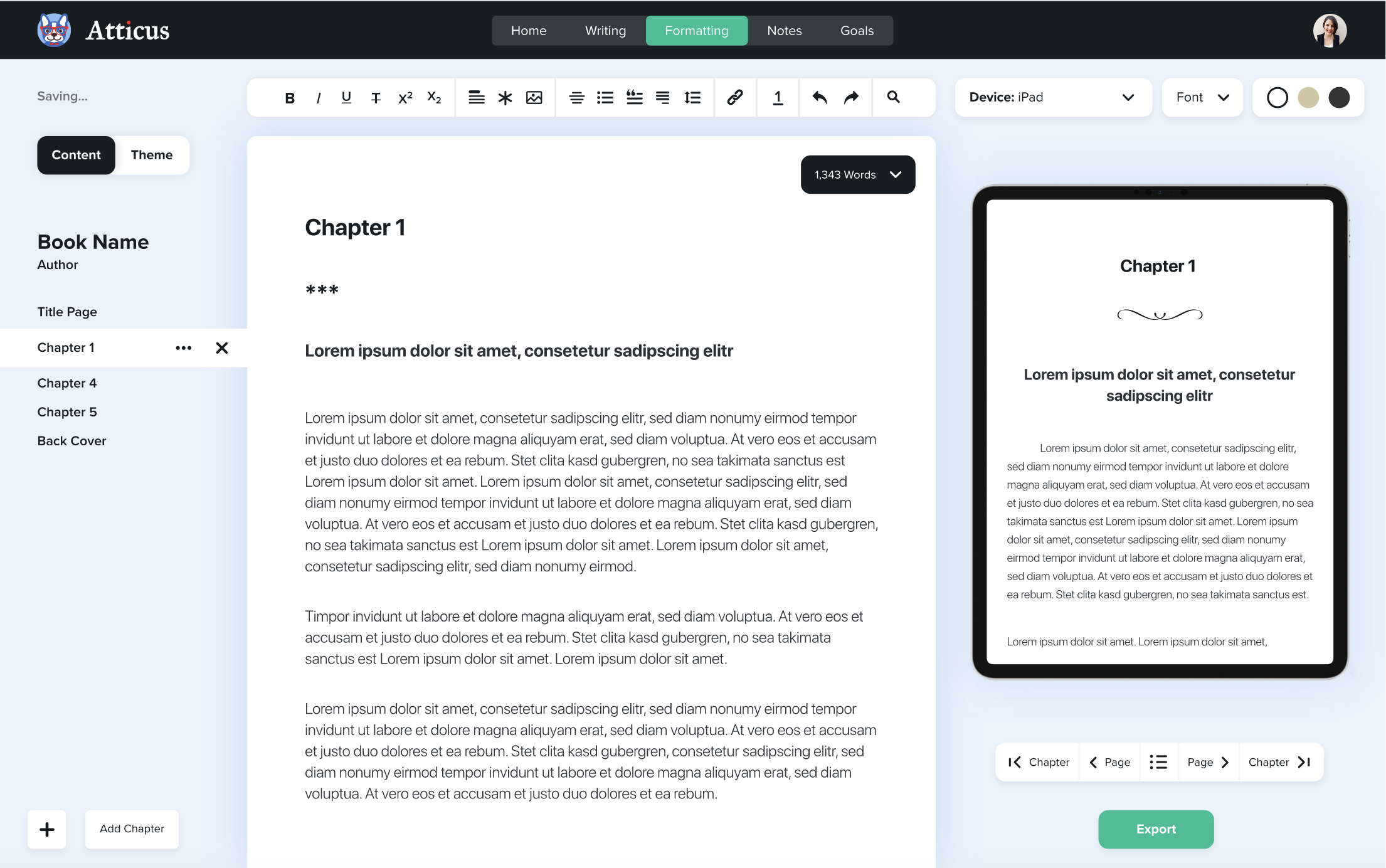The denouement is the final piece of a well-told story.
Done right, it leaves readers satisfied, tying up loose ends and showing the lasting effects of the climax. Done poorly (or skipped altogether), it can leave readers feeling unfinished or even frustrated.
Even if the term sounds unfamiliar, you’ve almost certainly felt its impact. The denouement is what gives a story closure. By understanding exactly what it is and how it works, you’ll be able to craft endings that deliver the payoff readers expect.
In this article, you’ll learn:
- 5 pro tips for writing a strong denouement
- What a denouement is and why it matters
- Denouement examples from popular stories
We'll begin with the definition.
What is a Denouement?
The word denouement comes from French, meaning “to untie the knot.” It’s a fitting image, because that’s exactly what this story element does. The denouement untangles the threads left behind after the climax, resolving any lingering plot points and giving the audience a sense of closure.
By definition, the denouement always comes at the very end (after the climax and falling action). Placing it earlier wouldn’t make sense, since its entire function is to wrap things up once the main conflict has already been resolved.
A Denouement by Any Other Name
If you’ve studied different story structures, you’ve probably seen the denouement under other names.
- In The Hero’s Journey, it’s the “Return With the Elixir.”
- In the Fichtean Curve, it’s included in the Falling Action.
- In Freytag’s Pyramid or the Three-Act Structure, it shows up as the final stage of resolution.
- Even Aristotle’s Poetics makes mention of this narrative step.
The terminology changes, but the idea doesn’t.
Every major story model reserves space for the denouement (aka the final chapter that leaves readers with a feeling of completion).

Format Beautiful Professional Books
Easy to use, and and full of amazing features, you can quickly turn your book into a professional book.
Check It OutDenouement vs Epilogue
Writers often mix up denouements and epilogues, but they aren’t the same thing. The denouement is a core part of story structure, while an epilogue is optional.
The denouement ties up the immediate loose ends of the plot and brings the story to a close.
An epilogue, on the other hand, goes beyond that. It usually offers extra context after the story is finished (sometimes with a jump forward in time to show the longer-term effects of the conflict). Many authors also use epilogues to hint at a sequel.
Most stories include a denouement right after the climax and falling action. Whether you choose to end there or add an epilogue afterward depends on the type of story you’re telling and what you want readers to walk away with.
Why the Denouement is Important
Think about one of your favorite books or movies. Picture the climax… the big confrontation, the darkest moment, the ultimate test. Now imagine the story ending right there, with no follow-up.
What if The Lord of the Rings: The Return of the King ended the moment the Ring was destroyed? No return to the Shire, no goodbyes, no sense of how the characters’ lives had changed. Or what if Pride and Prejudice stopped right after Darcy and Elizabeth finally confessed their love, with no glimpse of what their relationship would become? Even in film, imagine The Lion King cutting off immediately after Simba defeats Scar, with no scene of him reclaiming his place as king.
Each of those stories would feel incomplete, leaving readers and viewers without the closure that makes the journey satisfying.
That’s the job of the denouement. It provides closure after the intensity of the climax. It lets readers exhale, take stock of the journey, and tie up any remaining questions in their minds.
Without this final piece, even a great story can leave readers unsatisfied. And since reader satisfaction plays a huge role in reviews, word-of-mouth, and overall career growth, including a strong denouement is well worth the effort.
6 Great Denouement Examples
Now that we’ve covered why the denouement matters, let’s look at how different stories handle it. These examples show a range of ways to bring closure after the climax.
The Lord of the Rings Film Trilogy
The denouement of Peter Jackson’s trilogy lasts nearly twenty minutes (which was fitting after more than nine hours of storytelling). The hobbits return to the Shire, which remains unchanged, even after everything they’ve endured.
Sam marries and slips back into a familiar life. Frodo, however, cannot.
His wounds run too deep, and in the end, he leaves Middle-earth for the Undying Lands. It’s bittersweet but fitting, showing how the journey changed each hobbit in different ways.
The Great Gatsby by F. Scott Fitzgerald
The denouement arrives after Gatsby’s death, when Nick Carraway reflects on what he’s seen. Nearly everyone abandons Gatsby, leaving Nick almost alone at the funeral. He realizes the “rotten” nature of the East Egg elite and decides to return to the Midwest.
While Gatsby is gone, Nick’s observations help readers process the tragedy and underline the novel’s themes of illusion, corruption, and loss.
Pride and Prejudice by Jane Austen
After Elizabeth and Darcy’s marriage, we see the ripple effects on those around them. Bingley and Jane move nearby, and family tensions begin to ease.
The denouement doesn’t just settle Elizabeth’s arc, it also shows how her marriage reshapes the Bennet family, bringing reluctant relatives to acceptance. This wider view of the aftermath makes the resolution feel complete.
The Catcher in the Rye by J.D. Salinger
Salinger closes his novel with an unusual, understated denouement. Holden doesn’t spell out everything that happened, but he does confirm that he returned home and will go back to school.
His final reflections (missing people he claimed not to care about) hint at growth without locking it in. The story ends with closure, but also with ambiguity, leaving interpretation in the reader’s hands.
Harry Potter and the Deathly Hallows by J.K. Rowling
After the battle of Hogwarts, the denouement shifts to the school’s aftermath. Characters mourn the fallen, rebuild, and look toward the future.
Then, in the famous epilogue, we jump ahead to see Harry, Ron, and Hermione as adults sending their own children to Hogwarts.
The denouement here balances grief with hope, reminding readers that while the conflict is over, life carries on.
Of Mice and Men by John Steinbeck
The novel’s denouement comes after George shoots Lennie. Slim comforts George, while Carlson and Curley fail to grasp the weight of what just happened. The story ends quietly, but the silence underscores the tragedy.
This brief denouement shows how closure doesn’t need to be long. A few well-placed moments can leave a lasting impact.
5 Pro Tips for Writing a Denouement
Here are some practical ways to make your denouement work for your story.
1. There’s No Single “Right” Outcome
A denouement isn’t a one-size-fits-all plot element. It simply needs to be consistent with your theme and central conflict.
In a tragedy, the denouement might show the cost of failure, with characters paying the ultimate price. In a romance, it often highlights the couple finally together.
Whatever form it takes, the key is answering the major questions raised earlier in the story so readers walk away satisfied.
2. You Don’t Have to Include One (But You Probably Should)
Like any writing “rule,” the denouement isn’t mandatory. But skipping it is risky.
Readers may not know the term, but they’ll feel its absence. A story that ends right after the climax can come across as unfinished, leading to frustration and bad reviews.
Yes, there are successful books without denouements, but if you’re going to skip it, do so intentionally and understand the trade-off.
3. You Can Pair a Denouement With a Cliffhanger
Denouement and cliffhanger aren’t mutually exclusive. You can resolve the main conflict of the book while hinting at bigger questions for a series arc.
The Avengers films are a good example.
Each movie wraps up its central conflict with a denouement, but still leaves threads that feed into the larger Marvel storyline.
4. Re-State Your Themes and Give Space for Reflection
The denouement is your chance to underline your themes and let characters reflect on how they’ve changed. A sudden shift in tone or message can throw readers off, so keep it consistent with what came before.
Showing how the conflict shaped your characters gives readers the closure they’ve been waiting for.
5. Keep It Proportional to the Story
The length of your denouement should match the scope of the story.
A sprawling epic may need several scenes to tie everything together, while a short novel might only need a page or two. Aim for enough space to provide closure without dragging the ending out.
Final Word on Denouement
Whether you’re writing a short story, a mystery, a fantasy epic, or a romance, chances are your readers will expect a denouement. It’s one of the most common (and most important) ways to bring a narrative to a close.
The denouement gives readers time to breathe after the climax, answers lingering questions, and shows how the characters and world have changed.
Without it, even the most exciting story can feel incomplete. With it, you can deliver the closure that keeps readers satisfied and eager for more.
A good way to improve this skill is to pay attention to how other writers handle it. Look at how much room they give the denouement, how they tie up loose ends, and how they bring their themes full circle.
The denouement is the final piece of a well-told story.
Done right, it leaves readers satisfied, tying up loose ends and showing the lasting effects of the climax. Done poorly (or skipped altogether), it can leave readers feeling unfinished or even frustrated.
Even if the term sounds unfamiliar, you’ve almost certainly felt its impact. The denouement is what gives a story closure. By understanding exactly what it is and how it works, you’ll be able to craft endings that deliver the payoff readers expect.
In this article, you’ll learn:
- 5 pro tips for writing a strong denouement
- What a denouement is and why it matters
- Denouement examples from popular stories
We'll begin with the definition.
What is a Denouement?
The word denouement comes from French, meaning “to untie the knot.” It’s a fitting image, because that’s exactly what this story element does. The denouement untangles the threads left behind after the climax, resolving any lingering plot points and giving the audience a sense of closure.
By definition, the denouement always comes at the very end (after the climax and falling action). Placing it earlier wouldn’t make sense, since its entire function is to wrap things up once the main conflict has already been resolved.
A Denouement by Any Other Name
If you’ve studied different story structures, you’ve probably seen the denouement under other names.
- In The Hero’s Journey, it’s the “Return With the Elixir.”
- In the Fichtean Curve, it’s included in the Falling Action.
- In Freytag’s Pyramid or the Three-Act Structure, it shows up as the final stage of resolution.
- Even Aristotle’s Poetics makes mention of this narrative step.
The terminology changes, but the idea doesn’t.
Every major story model reserves space for the denouement (aka the final chapter that leaves readers with a feeling of completion).

Format Beautiful Professional Books
Easy to use, and and full of amazing features, you can quickly turn your book into a professional book.
Check It OutDenouement vs Epilogue
Writers often mix up denouements and epilogues, but they aren’t the same thing. The denouement is a core part of story structure, while an epilogue is optional.
The denouement ties up the immediate loose ends of the plot and brings the story to a close.
An epilogue, on the other hand, goes beyond that. It usually offers extra context after the story is finished (sometimes with a jump forward in time to show the longer-term effects of the conflict). Many authors also use epilogues to hint at a sequel.
Most stories include a denouement right after the climax and falling action. Whether you choose to end there or add an epilogue afterward depends on the type of story you’re telling and what you want readers to walk away with.
Why the Denouement is Important
Think about one of your favorite books or movies. Picture the climax… the big confrontation, the darkest moment, the ultimate test. Now imagine the story ending right there, with no follow-up.
What if The Lord of the Rings: The Return of the King ended the moment the Ring was destroyed? No return to the Shire, no goodbyes, no sense of how the characters’ lives had changed. Or what if Pride and Prejudice stopped right after Darcy and Elizabeth finally confessed their love, with no glimpse of what their relationship would become? Even in film, imagine The Lion King cutting off immediately after Simba defeats Scar, with no scene of him reclaiming his place as king.
Each of those stories would feel incomplete, leaving readers and viewers without the closure that makes the journey satisfying.
That’s the job of the denouement. It provides closure after the intensity of the climax. It lets readers exhale, take stock of the journey, and tie up any remaining questions in their minds.
Without this final piece, even a great story can leave readers unsatisfied. And since reader satisfaction plays a huge role in reviews, word-of-mouth, and overall career growth, including a strong denouement is well worth the effort.
6 Great Denouement Examples
Now that we’ve covered why the denouement matters, let’s look at how different stories handle it. These examples show a range of ways to bring closure after the climax.
The Lord of the Rings Film Trilogy
The denouement of Peter Jackson’s trilogy lasts nearly twenty minutes (which was fitting after more than nine hours of storytelling). The hobbits return to the Shire, which remains unchanged, even after everything they’ve endured.
Sam marries and slips back into a familiar life. Frodo, however, cannot.
His wounds run too deep, and in the end, he leaves Middle-earth for the Undying Lands. It’s bittersweet but fitting, showing how the journey changed each hobbit in different ways.
The Great Gatsby by F. Scott Fitzgerald
The denouement arrives after Gatsby’s death, when Nick Carraway reflects on what he’s seen. Nearly everyone abandons Gatsby, leaving Nick almost alone at the funeral. He realizes the “rotten” nature of the East Egg elite and decides to return to the Midwest.
While Gatsby is gone, Nick’s observations help readers process the tragedy and underline the novel’s themes of illusion, corruption, and loss.
Pride and Prejudice by Jane Austen
After Elizabeth and Darcy’s marriage, we see the ripple effects on those around them. Bingley and Jane move nearby, and family tensions begin to ease.
The denouement doesn’t just settle Elizabeth’s arc, it also shows how her marriage reshapes the Bennet family, bringing reluctant relatives to acceptance. This wider view of the aftermath makes the resolution feel complete.
The Catcher in the Rye by J.D. Salinger
Salinger closes his novel with an unusual, understated denouement. Holden doesn’t spell out everything that happened, but he does confirm that he returned home and will go back to school.
His final reflections (missing people he claimed not to care about) hint at growth without locking it in. The story ends with closure, but also with ambiguity, leaving interpretation in the reader’s hands.
Harry Potter and the Deathly Hallows by J.K. Rowling
After the battle of Hogwarts, the denouement shifts to the school’s aftermath. Characters mourn the fallen, rebuild, and look toward the future.
Then, in the famous epilogue, we jump ahead to see Harry, Ron, and Hermione as adults sending their own children to Hogwarts.
The denouement here balances grief with hope, reminding readers that while the conflict is over, life carries on.
Of Mice and Men by John Steinbeck
The novel’s denouement comes after George shoots Lennie. Slim comforts George, while Carlson and Curley fail to grasp the weight of what just happened. The story ends quietly, but the silence underscores the tragedy.
This brief denouement shows how closure doesn’t need to be long. A few well-placed moments can leave a lasting impact.
5 Pro Tips for Writing a Denouement
Here are some practical ways to make your denouement work for your story.
1. There’s No Single “Right” Outcome
A denouement isn’t a one-size-fits-all plot element. It simply needs to be consistent with your theme and central conflict.
In a tragedy, the denouement might show the cost of failure, with characters paying the ultimate price. In a romance, it often highlights the couple finally together.
Whatever form it takes, the key is answering the major questions raised earlier in the story so readers walk away satisfied.
2. You Don’t Have to Include One (But You Probably Should)
Like any writing “rule,” the denouement isn’t mandatory. But skipping it is risky.
Readers may not know the term, but they’ll feel its absence. A story that ends right after the climax can come across as unfinished, leading to frustration and bad reviews.
Yes, there are successful books without denouements, but if you’re going to skip it, do so intentionally and understand the trade-off.
3. You Can Pair a Denouement With a Cliffhanger
Denouement and cliffhanger aren’t mutually exclusive. You can resolve the main conflict of the book while hinting at bigger questions for a series arc.
The Avengers films are a good example.
Each movie wraps up its central conflict with a denouement, but still leaves threads that feed into the larger Marvel storyline.
4. Re-State Your Themes and Give Space for Reflection
The denouement is your chance to underline your themes and let characters reflect on how they’ve changed. A sudden shift in tone or message can throw readers off, so keep it consistent with what came before.
Showing how the conflict shaped your characters gives readers the closure they’ve been waiting for.
5. Keep It Proportional to the Story
The length of your denouement should match the scope of the story.
A sprawling epic may need several scenes to tie everything together, while a short novel might only need a page or two. Aim for enough space to provide closure without dragging the ending out.
Final Word on Denouement
Whether you’re writing a short story, a mystery, a fantasy epic, or a romance, chances are your readers will expect a denouement. It’s one of the most common (and most important) ways to bring a narrative to a close.
The denouement gives readers time to breathe after the climax, answers lingering questions, and shows how the characters and world have changed.
Without it, even the most exciting story can feel incomplete. With it, you can deliver the closure that keeps readers satisfied and eager for more.
A good way to improve this skill is to pay attention to how other writers handle it. Look at how much room they give the denouement, how they tie up loose ends, and how they bring their themes full circle.
The more examples you study, the easier it becomes to shape your own endings in a way that feels natural and rewarding.

Better Keywords & Categories Fast
See why over 47,000+ authors and publishing companies use and love Rocket to help them sell more books.
Get Publisher Rocket Now





